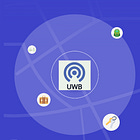UWB market news - 2024 year end update
From advanced radar SoCs, new UWB+BLE tag, new NXP collaboration for its UWB products, hands-free convenience, and versatile applications.
1. The NXP collaboration with Inventec
To enhance Taiwan’s automotive ecosystem involves a focus on Ultra-Wideband (UWB) technology to drive advancements in secure and connected vehicle solutions. The partnership emphasizes the integration of UWB for precise ranging and secure communication, benefiting applications like digital car keys, UWB radar for presence detection and more, using the NXP Trimesion products.
This partnership is set to accelerate the development of software-defined vehicles, turning industry concepts into tangible solutions. As the automotive sector strives for greater speed and efficiency, NXP is expanding its system solutions portfolio to support next-generation vehicle architectures, electrification, and enhanced smart and secure car access systems.
2. Hyundai is expanding the availability of its innovative credit card-sized smart keys
Initially introduced with the Ioniq 5N, to additional models like the Santa Fe, Tucson, and Grandeur. These smart keys integrate Ultra-Wideband (UWB) technology, enabling users to unlock, start, and park their vehicles without even removing the key from their pocket or bag. The UWB technology ensures precise proximity detection, offering seamless and secure access to the vehicle.
Key features of these smart keys include a 30-meter operational range, wireless charging capability, and durability for everyday use. Priced at 129,000 KRW, these smart keys have already gained traction in markets such as South Korea and are slated for further international expansion, including in North America. Hyundai is also considering custom designs for corporate fleets, catering to businesses and organizations. This development reflects Hyundai’s push towards more convenient and secure vehicle access solutions, driven by cutting-edge UWB technology.
Source (page in Korean language)
3. Changhong NeoNet, Truesense, and NXP Launch Neo-TAG: A New UWB+BLE IoT Tracking Device
At CES 2025, Changhong NeoNet, Truesense, and NXP Semiconductors will showcase the Neo-TAG, a new IoT tracking device designed to compete with Apple’s AirTag. The Neo-TAG addresses the growing demand for IoT asset tracking taking advantage of UWB higher precision ranging and cross-platform compatibility. A live demonstration will be available at the event.
Key Features:
Dual Communication Protocols: Supports both UWB and BLE for reliable connectivity.
Seamless Integration: Compatible with iOS, Android, Apple’s Find My network, Android's UWB TAG framework, and RTLS systems.
Battery Life: Powered by a replaceable CR2032 coin battery for convenience.
4. Shenzhen Tong Adopts NXP’s Trimension UWB for Hands-Free Transit Ticketing
Shenzhen Tong, the automatic fare collection provider for Shenzhen Transit, is deploying the NXP Trimension UWB portfolio to enable contactless ticketing. The system allows riders to walk through gates with UWB-enabled smartphones in their pockets or bags, eliminating the need to tap a phone or transit card.
UWB technology streamlines entry by using secure ranging to detect rider’s precise locations, enhancing convenience for commuters and improving efficiency by reducing wait times. Shenzhen Tong has integrated NXP’s Trimension SR100 in mobile devices and SR150 in transit gates (anchors), while the SR200 supports compatibility with next-gen smartphones.
The UWB ticketing system has already been implemented at Pingshan and SMIC Stations on the Yunba Line 1. Full deployment across all 11 stations is expected by October 2024. This marks a significant step forward in urban transit innovation, offering a seamless, hands-free experience for riders and further development in wireless UWB payment systems.
5. Aria Sensing Unveils "Hydrogen" UWB Radar SoC with Global Compliance
The new UWB radar SoC, is designed for advanced detection in 1D, 2D, and 3D applications. Fully compliant with global UWB regulations, Hydrogen operates across a frequency range of 7.3 GHz to 9.8 GHz.
The SoC integrates dual RISC-V microprocessors to reduce BOM costs, offering programmable pulse bandwidths ranging from 500 MHz to over 1.8 GHz. With support for up to four transmitting and four receiving antennas, Hydrogen ensures high precision and robust performance.
Hydrogen reflects Aria Sensing’s commitment to delivering innovative, cost-efficient UWB solutions for a wide range of applications, such as:
People Tracking: Locate individuals in the environment with precision.
Fall Detection: Identify and alert on fall events.
Contactless Vital Signs Monitoring: Measure heart rate and breathing remotely.
Driver Monitoring: Track vital signs and count in-cabin occupants.
Gesture Recognition: Control appliances with intuitive gestures.
Hidden Anti-Intrusion Sensors: Detect intruders with hidden sensors, even through walls.
Interested in the UWB market? Take a look into the other Q4 news, here:





